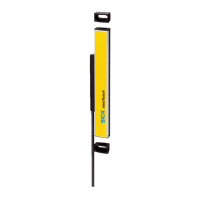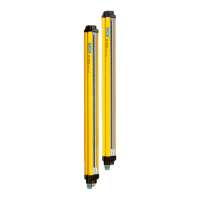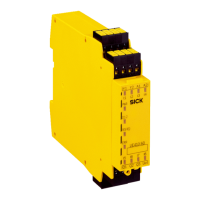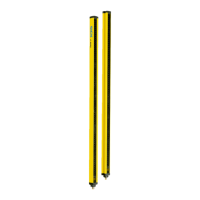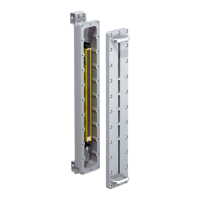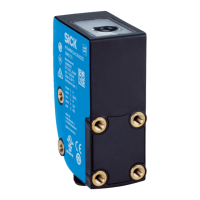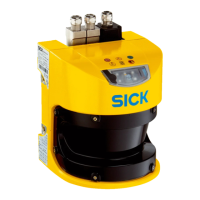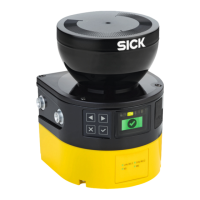
Do you have a question about the SICK microScan3 - EFI-pro and is the answer not in the manual?
| Scanning angle | 275° |
|---|---|
| Number of fields | Up to 128 |
| Number of monitoring cases | Up to 128 |
| Enclosure rating | IP65, IP67 |
| Number of protective fields | Up to 128 |
| Field sets | Up to 128 |
| Protective field range | 5.5 m |
| Resolution | 30 mm / 40 mm / 50 mm / 70 mm / 150 mm |
| Interface | Ethernet/IP, PROFINET |
| Ambient operating temperature | 0 °C ... +50 °C |
| Scanning range | 5.5 m (protective) |
| Safety integrity level | SIL3 (IEC 61508) |
| Performance level | PL e (ISO 13849) |
| Type | Type 3 |
| Detection capability | 30 mm |
| Operating voltage | 19.2 V DC to 30 V DC |
| Ambient temperature | 0°C to +50°C |
| Storage temperature | -25 °C ... +70 °C |
| Housing material | Aluminum |
| Connection | M12 connector |
| Safety standards | IEC 61496-1, IEC 61508, ISO 13849 |
Explains the purpose and content of the operating instructions.
Defines the applicability of the operating instructions to the microScan3 safety laser scanner.
Identifies different user groups and relevant chapters for each.
Provides information on where to find additional resources online.
Explains the meaning of symbols and conventions used in the document.
General safety guidelines and warnings for the safety laser scanner.
Describes the intended applications and limitations of the safety laser scanner.
Details prohibited uses and hazards associated with improper operation.
Specifies the qualifications required for different tasks related to the device.
Explains how the safety laser scanner works and its basic setup principles.
Details the features and components of the safety laser scanner.
Illustrates practical uses of the safety laser scanner.
Information for machine manufacturers regarding safety scanner integration.
Information for machine operators regarding scanner usage and safety.
Important information about the physical design and mounting of the device.
Safety precautions to be observed during the mounting process.
Instructions for safely unpacking the safety laser scanner.
Details the available options and steps for mounting the device.
Safety precautions for electrical installation.
Shows the connections and ports available on the safety laser scanner.
Details the pin configuration for various connectors.
Describes delivery state and preparations for configuration.
Introduces Safety Designer software for scanner configuration.
Provides an overview of the Safety Designer's dialog box and its information.
Explains how to configure IP settings for network communication.
Describes how to read and compare device configuration.
Details how to assign names and information for unique identification.
Explains how to select and configure application types for the scanner.
Describes how to define scan plane parameters for monitoring.
Explains how to draw and configure reference contour fields for environment monitoring.
Covers using the field editor to configure protective and warning fields.
Details how to configure inputs and outputs for controlling scanner functions.
Explains how to create and manage monitoring cases for different machine states.
Describes how to visualize and test the configured settings.
Explains how to configure data output via UDP or TCP/IP.
Details the process of transferring configuration files.
Explains how to manually start and stop the safety function.
Describes how to generate and manage reports of device data.
Covers service options available through Safety Designer.
Safety precautions during the commissioning phase.
Steps for precisely aligning the safety laser scanner.
Describes the procedure and status after switching on the device.
Requirements for thorough checks during commissioning and specific situations.
Safety precautions to be observed during the operation of the device.
Guidelines for regularly checking the effectiveness of the protective device.
Explains the status and network indicator LEDs on the device.
Describes the function of the device's pushbuttons and display.
Safety precautions to be observed during maintenance activities.
Instructions for cleaning the optics cover and checking for contamination.
Procedures for replacing the optics cover and the necessary calibration.
Steps for replacing a defective safety laser scanner.
Procedures for replacing the system plug if it is damaged or defective.
Guidelines for regular checks to ensure the protective device's effectiveness.
Safety precautions to be taken when troubleshooting the device.
Explains the status and network LEDs for initial diagnostics.
Details how to interpret status information shown on the device display.
Describes diagnostic tools available within the Safety Designer software.
Instructions for the proper disposal of unusable devices according to regulations.
Lists available device variants and their corresponding type codes and part numbers.
Explains how to identify device functionality levels using version numbers.
Provides detailed technical features and specifications of the microScan3 – EFI-pro.
Details the device's response time and factors influencing it.
Specifies the protective field and warning field ranges based on resolution and scan cycle time.
Describes how data is exchanged in the network via assemblies.
Provides detailed physical dimensions and mounting points of the device.
Lists the items included in the product package.
Provides part numbers and type codes for ordering the microScan3 Core and Pro models.
Lists part numbers for safety laser scanners without system plugs.
Provides ordering information for the system plug.
Lists other available spare parts like optics covers.
Ordering information and dimensional drawings for various mounting brackets.
Ordering information for connecting cables (M12, Ethernet, USB).
Information on ordering aids for precise alignment.
Information on ordering cleaning agents.
Ordering information for test rods used for checks.
Ordering information for safety controllers.
Lists other miscellaneous accessories, including tools.
Declares conformity with EU directives and provides download info.
Lists relevant regional standards and their equivalents.
Provides a checklist for manufacturers and installers for initial setup.
Describes mounting methods to avoid interference between scanners.
